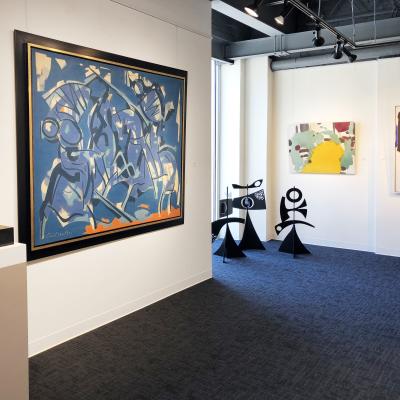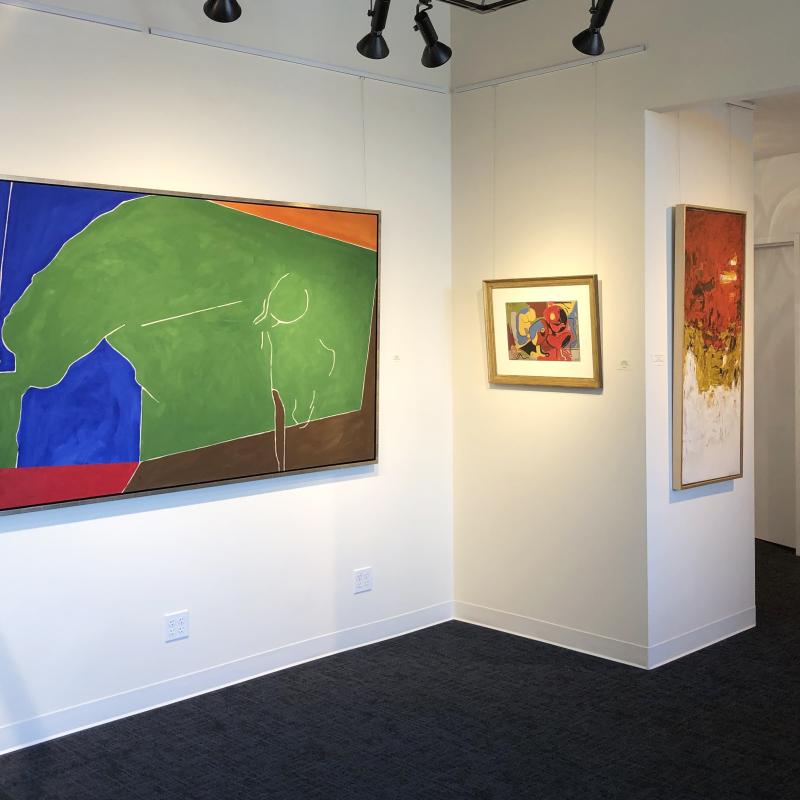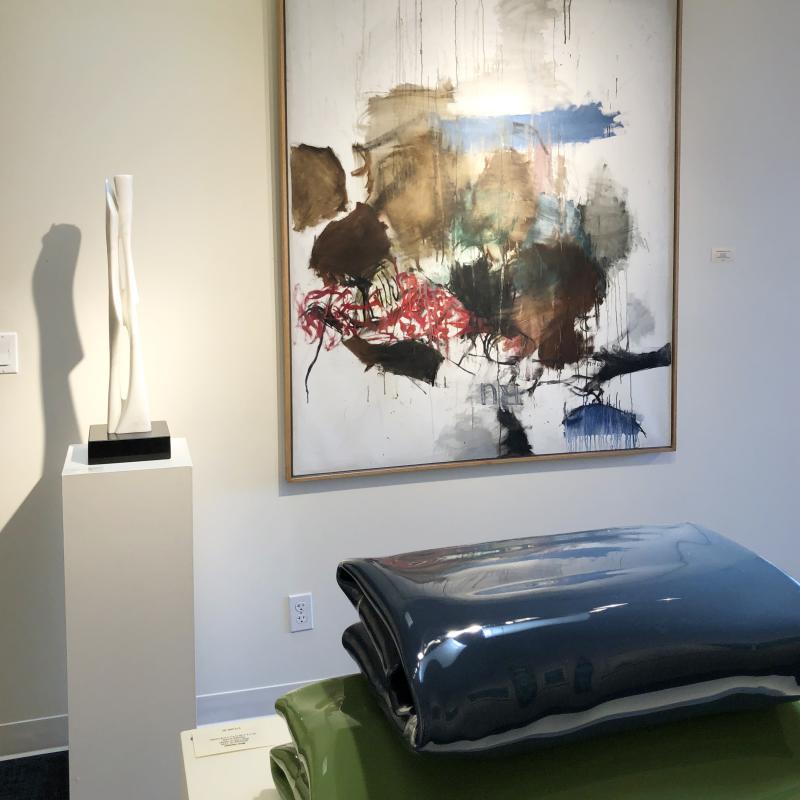-
 Carl HoltyAmerican, 1900-1973Clybourn II, 1966Signed: Holty lower leftOil on canvas65 x 54 3/4 inchesFramed: 68 x 57 inches
Carl HoltyAmerican, 1900-1973Clybourn II, 1966Signed: Holty lower leftOil on canvas65 x 54 3/4 inchesFramed: 68 x 57 inches -
 Edward DugmoreAmerican, 1915-1996Black White Red, 1963Oil on canvas72 x 56 inches
Edward DugmoreAmerican, 1915-1996Black White Red, 1963Oil on canvas72 x 56 inches -
 Jack RothAmerican, 1927-2004New Synthesis 16, 1981Signed: Jack Roth 81 (verso),Marked: New Synthesis 16 32304 Roth 81 (verso)Acrylic on canvas47 3/4 x 84 inchesFramed: 49 1/8 x 85 3/8 inches
Jack RothAmerican, 1927-2004New Synthesis 16, 1981Signed: Jack Roth 81 (verso),Marked: New Synthesis 16 32304 Roth 81 (verso)Acrylic on canvas47 3/4 x 84 inchesFramed: 49 1/8 x 85 3/8 inches -
 Carl HoltyAmerican 1900-1973Abstract, 1959Signed: Holty 59 lower right and Holty upper leftOil on Canvas15 x 23 inchesFramed: 23 1/4 x 31 1/4 inches
Carl HoltyAmerican 1900-1973Abstract, 1959Signed: Holty 59 lower right and Holty upper leftOil on Canvas15 x 23 inchesFramed: 23 1/4 x 31 1/4 inches -
 Edward DugmoreUntitled, 1953Oil on canvas
Edward DugmoreUntitled, 1953Oil on canvas -
 Carl HoltyAmerican, 1900-1973Biomorphic Abstraction, c. 1936Signed: Carl Holty (l.l.)Gouache on paper16 1/4 x 23 1/8 inches (sight)Framed: 24 1/2 x 31 1/2 inches
Carl HoltyAmerican, 1900-1973Biomorphic Abstraction, c. 1936Signed: Carl Holty (l.l.)Gouache on paper16 1/4 x 23 1/8 inches (sight)Framed: 24 1/2 x 31 1/2 inches
-
 Carl HoltyAmerican 1900-1973Federation, c. 1950’sSigned: Holty lower right,Marked: Federation (verso)Oil on canvas16 x 24 inchesFramed: 24 x 32 inches
Carl HoltyAmerican 1900-1973Federation, c. 1950’sSigned: Holty lower right,Marked: Federation (verso)Oil on canvas16 x 24 inchesFramed: 24 x 32 inches -
 Carl HoltyAmerican, 1900-1973Ascending, c. 1955Signed: Holty lower rightOil on canvas52 x 38 inchesFramed: 53 1/2 x 39 1/2 inches
Carl HoltyAmerican, 1900-1973Ascending, c. 1955Signed: Holty lower rightOil on canvas52 x 38 inchesFramed: 53 1/2 x 39 1/2 inches -
 Carl HoltyAmerican, 1900-1973Color Theory, Red Square #10, c. 1955Signed: Holty estate signature stamp l.r.,Marked: #10 (verso), Estate of Carl Holty stamp, versoOil on canvas mounted on Masonite11 5/8 x 8 7/8 inchesFramed 20 x 17 inches
Carl HoltyAmerican, 1900-1973Color Theory, Red Square #10, c. 1955Signed: Holty estate signature stamp l.r.,Marked: #10 (verso), Estate of Carl Holty stamp, versoOil on canvas mounted on Masonite11 5/8 x 8 7/8 inchesFramed 20 x 17 inches -
 Carl HoltyAmerican, 1900-1973Color Theory #571Orange, Greens, White, 1972Signed: Holty Estate signature stamp lower right,Marked: 1972 / ‘72 / 571 (verso) Andrew Crispo Gallery label (verso) Members’ Gallery Albright-Knox Art Gallery label (verso), Estate of Carl Holty stamp, versoOil on canvas mounted on Masonite12 x 9 inchesFramed: 20 x 17 inches
Carl HoltyAmerican, 1900-1973Color Theory #571Orange, Greens, White, 1972Signed: Holty Estate signature stamp lower right,Marked: 1972 / ‘72 / 571 (verso) Andrew Crispo Gallery label (verso) Members’ Gallery Albright-Knox Art Gallery label (verso), Estate of Carl Holty stamp, versoOil on canvas mounted on Masonite12 x 9 inchesFramed: 20 x 17 inches -
 Carl HoltyAmerican, 1900-1973Color Theory, Yellow Square #6, c. 1955Signed: Holty Estate signature stamp lower right,Marked: #6 (verso), Estate of Carl Holty stamp, versoOil on canvas mounted on Masonite12 x 9 inchesFramed: 20 x 17 inches
Carl HoltyAmerican, 1900-1973Color Theory, Yellow Square #6, c. 1955Signed: Holty Estate signature stamp lower right,Marked: #6 (verso), Estate of Carl Holty stamp, versoOil on canvas mounted on Masonite12 x 9 inchesFramed: 20 x 17 inches -
 Carl HoltyAmerican, 1900-1973Escapades #348, c. 1945Signed: Holty Estate signature stamp lower right,Marked: + / top / 348 (verso)Gouache on paperSight: 11 1/2 x 17 1/2 inchesFramed: 21 1/2 x 27 1/2 inches
Carl HoltyAmerican, 1900-1973Escapades #348, c. 1945Signed: Holty Estate signature stamp lower right,Marked: + / top / 348 (verso)Gouache on paperSight: 11 1/2 x 17 1/2 inchesFramed: 21 1/2 x 27 1/2 inches -
 Carl HoltyAmerican, 1900-1973Figure Composition #1, c. 1930’sSigned: Holty Estate signature stamp lower rightGouache on paper11 1/2 x 17 1/4 inchesFramed: 21 1/4 x 27 inches
Carl HoltyAmerican, 1900-1973Figure Composition #1, c. 1930’sSigned: Holty Estate signature stamp lower rightGouache on paper11 1/2 x 17 1/4 inchesFramed: 21 1/4 x 27 inches -
 Carl HoltyAmerican, 1900-1973Joust, 1945Signed: Carl Holty lower leftOil on canvas56 x 68.5 inches, framed: 64.5 x 77 inches
Carl HoltyAmerican, 1900-1973Joust, 1945Signed: Carl Holty lower leftOil on canvas56 x 68.5 inches, framed: 64.5 x 77 inches -
 Carl HoltyAmerican 1900-1973Moving Red, 1963Signed: Holty lower rightOil on canvas60 x 46 inchesFramed: 62 x 48 inches
Carl HoltyAmerican 1900-1973Moving Red, 1963Signed: Holty lower rightOil on canvas60 x 46 inchesFramed: 62 x 48 inches -
 Carl HoltyAmerican, 1900-1973Red, Gray, 1966Signed: Holty lower leftOil on canvas72 x 56 inches74 1/4 x 58 1/4 inches
Carl HoltyAmerican, 1900-1973Red, Gray, 1966Signed: Holty lower leftOil on canvas72 x 56 inches74 1/4 x 58 1/4 inches -
 Carl HoltyAmerican, 1900-1973Separation, 1957, 1957Signed: Holty lower rightOil on canvas52 x 36 inchesFramed: 54 x 38 inches
Carl HoltyAmerican, 1900-1973Separation, 1957, 1957Signed: Holty lower rightOil on canvas52 x 36 inchesFramed: 54 x 38 inches -
 Carl HoltyAmerican, 1900-1973Untitled #161, c. 1963Signed: Holty (on stretcher, verso)Oil on canvas48 x 35 inchesFramed: 49 1/4 x 37 1/4 inches
Carl HoltyAmerican, 1900-1973Untitled #161, c. 1963Signed: Holty (on stretcher, verso)Oil on canvas48 x 35 inchesFramed: 49 1/4 x 37 1/4 inches
Overview
American Artists Carl Holty, Edward Dugmore and Jack Roth each made significant contributions to the development of modern art in the United States though their artistic styles and approaches differed from one another significantly.
Carl Holty was a German-born American abstract painter who was instrumental in the formation of the Post-War Abstract Expressionist movement. Known for his use of bright colors and geometric forms, his work evokes a sense of cosmic energy and dynamism. Holty often sought to create a sense of harmony and balance through his use of color and form.
Edward Dugmore, on the other hand, was an American painter and sculptor who was associated with the Minimalist movement. He was known for his spare, minimalist compositions that emphasized simple shapes and clean lines often characterized by its starkness and austerity, sense of purity, and simplicity.
Jack Roth, meanwhile, was an American painter who was associated with the Color Field movement. He was known for his large, abstract canvases that featured bold, vibrant colors and subtle variations in hue and tone. Roth's work was often characterized by its luminosity and depth, and he sought to create a sense of radiance and transcendence through his use of color.


























